Road sign "Give way": description, rules and meaning
The traffic has become last years very intense, and its system of regulation has become of great importance and even a vital necessity. Notorious signs installed on the carriageways are actively involved in this process. They are divided into several categories, among which, for example, warning and prohibition. Their action is aimed at streamlining traffic on the roads, because without adjustment real chaos can occur.
Here we will consider one of the signs of traffic rules, which is included in the priority group - “Give way”.
External signs
The triangle shape is used in warning and priority signs. Framed in a red border, it focuses the driver's attention on a certain action, which he must adhere to without fail. The sign also warns the driver that there is an intersection ahead. main road with a secondary one or an adjunction of the latter.
It is an inverted triangle shape on a white background, with a red line around the edges. It was issued In a similar way so that the sign does not look like all the others and is recognizable by the driver even in conditions of poor visibility. Also, for example, the symbol with the inscription STOP in the form of an octagon has a unique shape. These signs have special meaning, therefore, should be recognizable by road users as best as possible.
Oddly enough, but appearance The sign has not changed since the beginning of the 20th century, when these symbols were just introduced to regulate traffic. But then it had a different name: "Do not interfere."

There are situations when the sign becomes unreadable, for example, it can be covered with snow or dirty with mud. Accordingly, if the sign resembled the rest in shape and color, it would become unrecognizable. In addition, there is one important plus - it is also easily distinguishable from the oncoming lane. For comparison, on foreign roads this symbol is the same, only the inscription Give Way is added to it.
What definition is given to him in the traffic rules of the Russian Federation?
The “Give way” sign means that it is forbidden to interfere. This means that you can not start, continue or resume the course of the car. In addition, the sign prohibits maneuvering if other participants with an advantage are forced to change the speed of the car or the trajectory of movement. Thus, an indication of the lack of an advantage for some road users is the information that this sign implies in such a situation.
It is necessary to give way at the intersection to those vehicles that drive on the crossed road, and in the case of the existing sign "Main Road" - moving along it. In order for the transport on the priority road to pass without any obstacles, you need to slow down as much as possible or stop.
It is possible to continue driving with this sign, if this does not interfere with the cars that drive on the main road, for example, when the road is empty.
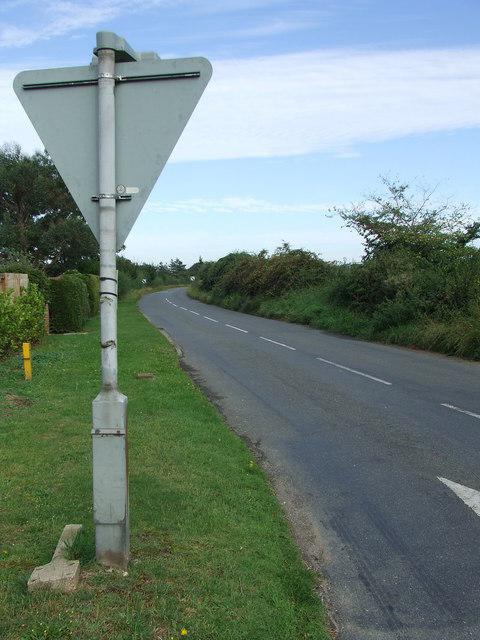
Installation location
As a rule, it is located just before the intersection of roads, however, it can also be used as a backup, that is, it can be installed additionally at a certain distance from the main one. Also, the sign can be located at a distance from the intersection, namely 150-300 meters outside settlements. At the same time, along with it is a sign: "Distance to the object."
It should be noted that often this sign is often located in front of a railway crossing, but loses its effect if there is a traffic light at such a crossing. The sign, as a rule, is installed at the exit from dirt roads to the paved part, onto the motorway (high-speed lane), as well as at the exit points from adjacent territories.
It cannot be ignored under any circumstances, since it is mainly located in front of the intersection at which poor visibility is noted, and, accordingly, the risk of an accident is increased.
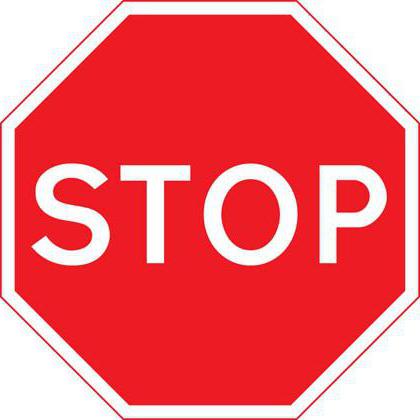
Sharing with other pointers
Based on the traffic rules, the “Give way” sign is often supplemented by some symbols that give the right of way through the intersection. In the event that the intersection has a complex layout, or the main road changes its direction at it, a sign called “Direction of the main road” is installed.
If a road conditions assume the presence of this sign, then outside the settlements it is pre-installed 150-300 meters before the intersection. Usually the sign is accompanied by a sign: "Distance to the object." Sometimes a “Give Way” sign is in tandem with a similar additional sign, but it contains information about the distance to the intersection in front of which the STOP sign is placed.
The signs "Give way" and "Movement without stopping is prohibited" are similar in their meaning. In this case, there is one exception: in the latter case, the participant in the movement, regardless of the circumstances, must stop before the edge of the crossed carriageway or the stop line.
Give way sign: give priority to pedestrians?
Based on the traffic rules, the sign determines the order of passage of vehicles. By itself, it has nothing to do with pedestrians. Thus, the effect of the “Give Way” sign does not apply to them.
But it is always necessary to take into account the circumstances that have arisen in this moment time on the road. For example, if a person is on the roadway, it does not matter if there are any signs. In addition, other rules should be taken into account, under which the driver is obliged to give way to people. In any case, it is better to slow down in advance and be prepared for the fact that the pedestrian will begin to cross carriageway.
When a pedestrian must give way
If the driver makes an exit from the adjacent territory, then he must give way to those who walk along the sidewalk along the main road. This obligation is based on a mandatory rule, which states that in such a case, pedestrians must be allowed to pass, regardless of the signs available.
The main right of priority for a pedestrian is the existing crossing, both regulated and ordinary "zebra", which obliges the driver to stop in order to let moving people through.
If not pedestrian crossing, then a person should not cross the road at this place, interfering with vehicles, and forcing them to brake sharply or make maneuvers to avoid collision. Thus, the pedestrian does not have priority over cars on such a section of the road, regardless of the presence (absence) of the sign in question.

At the same time, based on the SDA, it must be borne in mind that there is an exception to the rule. A pedestrian crossing the roadway along a sidewalk or shoulder line has priority over vehicles exiting the intersection completing a turn in either direction. In this case, if there is a “Give way” sign (also in the absence of one), the driver must give way to pedestrians.
This symbol is often placed at regulated intersections, usually next to a traffic light, preferably on a pole.
Penalty for violation
If for some reason you did not follow the rule indicated by the “Give way” sign, then the traffic police may impose a fine of 1 thousand rubles.
Once you have passed the intersection, the power of the “Give Way” sign in place no longer affects further traffic, that is, it only applies to a specific place.
Traffic light and give way sign
With a valid traffic light, the priority signs cancel their effect, that is, the “Give way” sign will be inferior in importance to the green signal of the regulating device. An idle traffic light is off or with a flashing yellow signal. In this case, the priority signs come into force again.
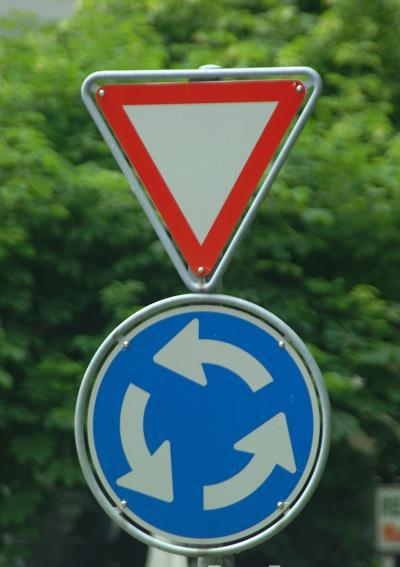
But it should be remembered that when driving along the main road, when making a maneuver, you must make sure that a vehicle with a blue beacon or a special sound signal. These cars have priority regardless of the presence of signs.
From compliance with traffic rules not only the order on the roads depends, but also the safety of drivers and pedestrians. Signs are designed to make traffic in the traffic more orderly, so you need to be careful about them. The sequence of passage on the road, which is established by this symbol, is extremely important for ensuring traffic safety.
Answer. The intersection you are entering is regulated traffic light. When turning left, you must give way to a bus moving straight from the opposite direction, and, completing the turn, to pedestrians crossing the carriageway into which you are turning.
When driving straight ahead:
 |
Answer. You are approaching a regulated intersection and you can pass it without stopping because the green permit signal is on traffic light. You must comply with the requirement of the “ ” sign only if the traffic light is turned off or switched to the yellow flashing signal mode.
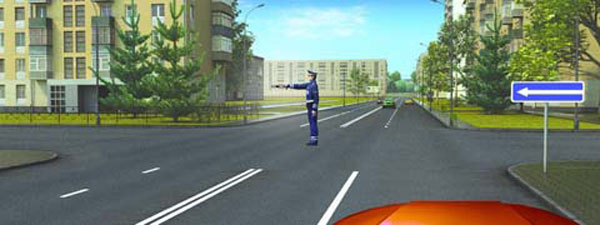 |
||||||||||||
|
Answer. In this situation, the traffic controller does not change the organization of traffic existing at the intersection. If you are on the right lane, you can only go straight through the intersection, as the “ ” sign prohibits turning right. For a left turn or U-turn, it was necessary to occupy the left lane.
Which driver can continue driving?
 |
||||||||||||
|
Answer. Adjuster for some reason took control of the traffic at the intersection. Drivers must comply with the requirements of its signals, despite the fact that they contradict traffic signals. Based on his signal, both drivers can continue driving.
Who must give way?
Answer. At this intersection, the traffic order is determined not by priority signs, but by signals traffic light, i.e. the intersection is regulated. The driver of a tram moving in the direction of the arrow switched on in the additional section at the same time as the red signal of the traffic light must give way to a car passing on the crossed road from the left to the green signal.
With such a gesture of the traffic controller and traffic signals, you must:
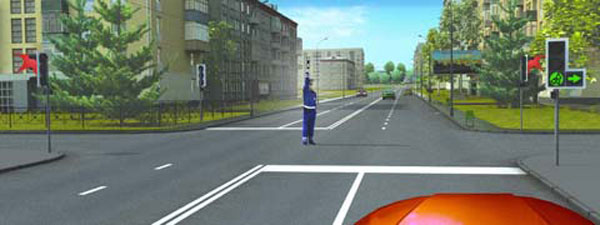 |
Answer. In this situation, due to some circumstances, the traffic controller intervened in the management road traffic, and you must comply with his requirement - to stop in front of the stop line, although the traffic light allows movement.
You intend to turn right. Should you give way to a car?
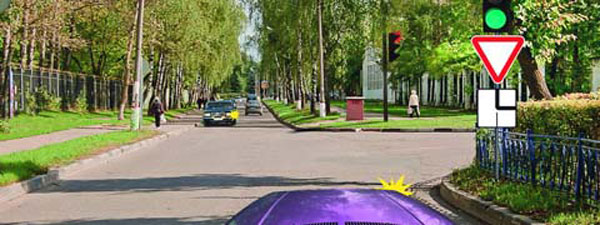 |
||||||
|
Answer. This intersection is regulated, and the sequence of movement on it is determined not by priority signs, but by signals traffic light. When turning right, you have priority over an oncoming car turning left.
What should you be guided by if the meanings of road signs and horizontal marking lines contradict each other?
| 1. | Marking line requirements. | |
| 2. | road sign requirements. | |
| 3. | The rules do not cover this situation. |
Answer. Drivers must be guided by the requirements of road signs, including temporary ones, placed on a portable stand, if they contradict the requirements of horizontal marking lines.
What should you be guided by if the white and orange marking lines on the roadway contradict each other?
Answer. In this situation, drivers should be guided by the time markings orange color, which is used when changing the organization of traffic, for example, in connection with the production repair work on the road.
You intend to turn left. Who should give way?
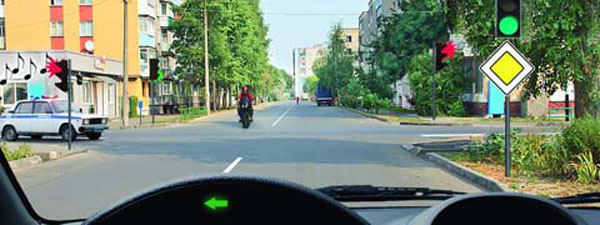 |
Answer.
- At regulated intersections, the order of traffic is determined not by priority signs, but by signals traffic light.
- In addition, you need to let the car pass with the flashing beacon turned on. of blue color and a special sound signal.
- When turning left, you must also give way to a motorcyclist moving straight in the opposite direction.
Which road signs are canceled by traffic lights?
| 1. | Priority signs. | |
| 2. | Forbidding signs. | |
| 3. | Prescriptive signs. | |
| 4. | All listed. |
Answer. An intersection at which traffic order is determined by signals traffic light, is considered to be regulated. Priority signs that establish the order of passage through unregulated intersections do not work in this case. Keep in mind that traffic lights do not override other road signs.
What should drivers be guided by if the instructions of the traffic controller contradict the meanings of traffic lights and the requirements of road signs?
Answer. Signals traffic controller take precedence over traffic signals, road signs or markings. In such situations when adjuster prescribes to drivers and pedestrians a traffic order different from that provided by the existing traffic organization, he, as a rule, gives additional gestures or signals explaining the changes. So, you must follow the instructions traffic controller, even if they contradict traffic signals and traffic signs.
What color is the temporary horizontal marking?
Answer. Temporary horizontal markings are orange.
In what directions are you allowed to move?
Answer. In this situation, the traffic controller does not change the organization of traffic existing at the intersection. The signal of the traffic controller and the road sign "Exit to the road with one-way traffic" allow you to pass the intersection only straight or to the right.
In what directions can you continue moving?
Answer. In this situation, the traffic controller performs the function of a traffic light and
A “Give Way” sign does not have to be installed at every intersection. It is needed to prevent accidents on difficult sections of the route.
Important ! “Give way” does not mean a mandatory stop.
The red triangle calls the driver to increased attention in this sector of the route. If you don’t see any traffic on both sides, feel free to drive through, this will not be a violation.
History of occurrence
Interesting fact! Even under Peter 1, there were road signs. These were milestones, which indicated the distance to a certain village or settlement.
The first analogues of modern signs appeared in 1903. In Russia, similar signs were introduced in 1909. Oddly enough, but the picture of the “Give way” sign of that time was the same as it is now.
That's just it was called quite differently, namely "Do not interfere." Over time, more than one name has changed, but the plate has always remained the same. So that you don’t confuse this symbol with anything, here is another photo of the Give Way sign, but from a different angle:

detailed information
In order to skillfully navigate the traffic rules, you need to know the number of the “Give way” sign, namely 2.4. It's also important to have general idea about the features of the installation of the sign "Give way" in accordance with GOST. This will avoid annoying situations and manipulations by inspectors. These symbols are placed in the following places:
- When exiting the motorway.
- When leaving the dirt on the asphalt surface.
- At intersections where it is difficult to recognize the main and adjoining lanes.
- Where there is a fast lane before an intersection.
- At the beginning of the conjugation curve.
Important ! According to the traffic rules for 2015, the fine for violating the “Give way” rule ranges from 500 to 1000 rubles. The most large sum charged if the offense was committed at an intersection.
The zone of action of the sign "Give way" ends after the carriageway. If you passed the intersection, then you are no longer required to follow this rule. Accordingly, we can conclude that the designation does not have a zone. Owner vehicle is obliged to give way to other vehicles only when leaving the crossroads.
Combination with other signs on the road

Large white letters "STOP" on a red background indicate the need to stop at the edge of the carriageway or at the line.

Indicates the direction of movement. The main roadbed is a greasy black stripe on a white background. The combination of signs tells the driver that he must give way to another car.

End of the main roadway.
Ambiguous traffic situations associated with this marking
What does the “Give way” sign mean if there is a sign below it that says “Stop” and the distance is indicated?

A similar designation is established in order to warn the driver that at a certain distance from given point stop at the crossed line.
How to drive through a roundabout?
The driver must wait until the cars on the circular track pass and only then start moving. If a sign indicating the direction of the main road is additionally installed, the cars of the main lane have priority.
Where should you stay?
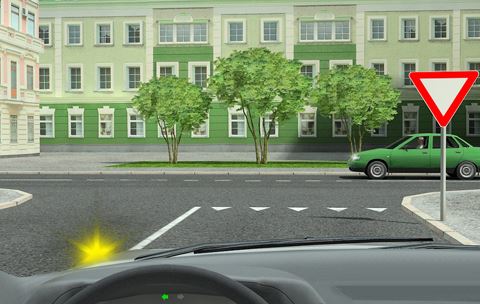
If you see a “Give way” sign at an intersection, and, having assessed the situation, you understand that you need to stop, you need to do it right. Usually on the pavement there is a marking in the form of a series of white triangles. Stop right in front of it and wait for the cars to pass and the traffic will be free.
What to do if there is a truck ahead?
![]()
The rules do not forbid you to turn at the same time as the tractor. When passing by the right sides, the trajectories of the cars do not intersect. Therefore, all you need to do is make sure in the direction of the turn of the truck. It is also necessary to take into account the dimensions of the second participant in the movement. You should not interfere with him when turning.
Start of movement and "Give way"
Sometimes on the track there are ambiguous events that require a detailed decoding of the “Give way” sign. The situation is as follows: the first participant dropped off the passenger and went along the main road to the fork; at this time, a car is driving on the other side, who should stop in this case?
Important ! According to the traffic rules, if the owner of the vehicle drops off a passenger before a fork, he must stop.
Solution to this challenging task presented in this video:
What should be the actions of the driver if he drives up to the fork from the secondary road, and along the main road from two different sides vehicles moving?

According to the traffic rules, the “Give way” sign in such a situation obliges the driver skip both cars and only then resume movement.
You are approaching a fork, where there is a traffic light and a sign, a car is moving towards you, what are your actions?

As you can see from the picture, the “Give way” road sign is located directly under the traffic light. According to the traffic rules, in such a situation, the driver must be guided by traffic lights. You have priority over a car turning left.
Combination of signs and cars from all sides
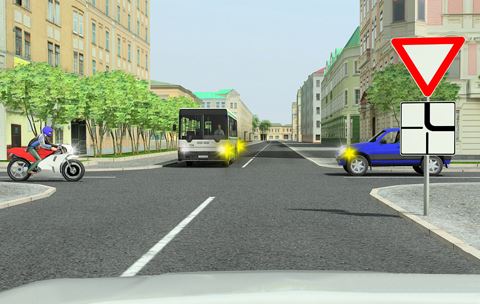
When approaching an intersection from a secondary road, according to clause 13.9, the effect of the “Give way” sign applies to a bus and a car. But this rule does not apply to motorcycles. This incident is connected with the equivalence of both lanes, because for a motorcyclist your car is an obstacle on the right side.
Outcome
The sign is combined with many other signs that are informational or warning. In some cases, they require the driver to take immediate action.
- Burns, Robert - short biography
- The concept of common vocabulary and vocabulary of limited use
- Nancy Drew: The Captive Curse Walkthrough Nancy Drew Curse of Blackmoore Manor Walkthrough
- Deadpool - Troubleshooting
- Won't start How to Survive?
- What to do if bioshock infinite won't start
- Walkthrough Nancy Drew: Alibi in Ashes
- Spec Ops: The Line - game review, review Spec ops the line crashes on missions
- Room escape level 1 walkthrough
- Processing tomatoes with boric acid How much will 2 grams of boric acid
- Cucumber Grass (Borago)
- Bioinsecticide Lepidocid: purpose, properties and application procedure Lepidocide waiting period
- How to change the language to Russian in steam
- Dendrobium noble: room care
- Morphology of plants general concepts - document
- Planting, propagation and care of bamboo at home, photo Growing bamboo from seeds
- How to strengthen the cellular signal for the Internet in the country
- Sanskrit reveals the forgotten meaning of Russian words (2 photos)
- The oldest language Sanskrit programming language of the future Dead language Sanskrit
- Who has dominion over all the earth?









